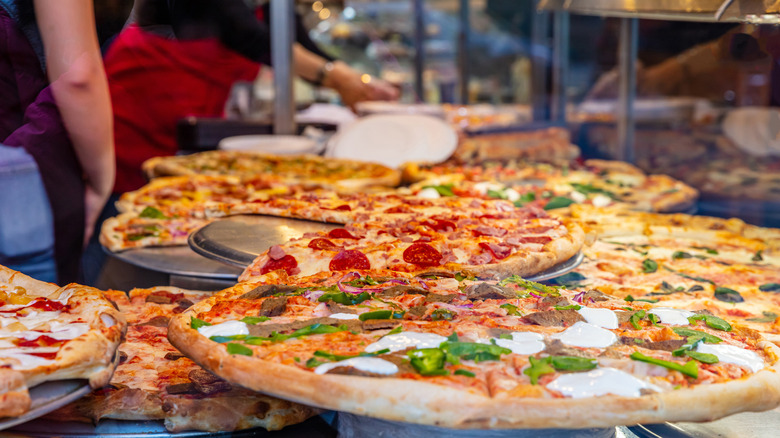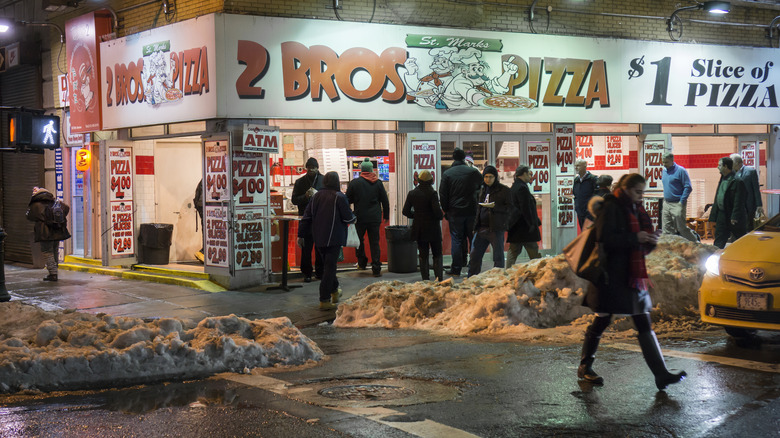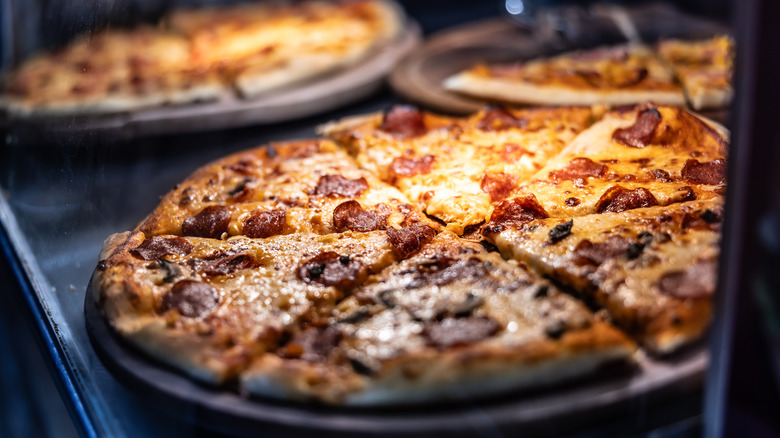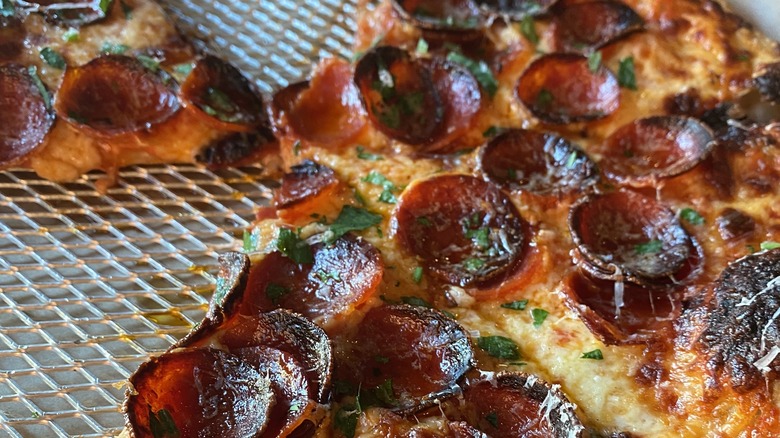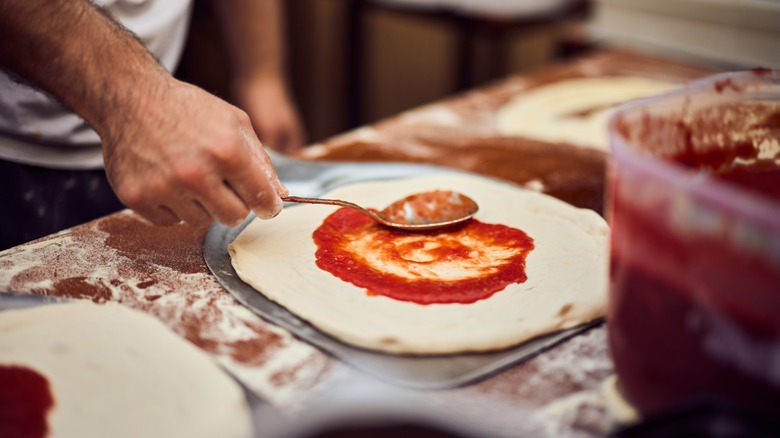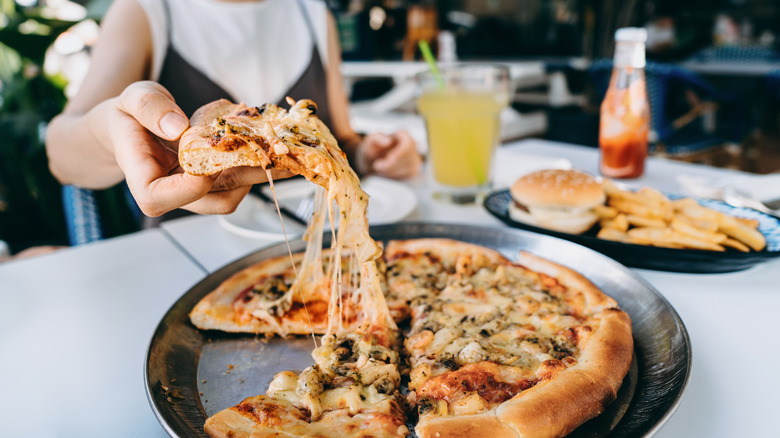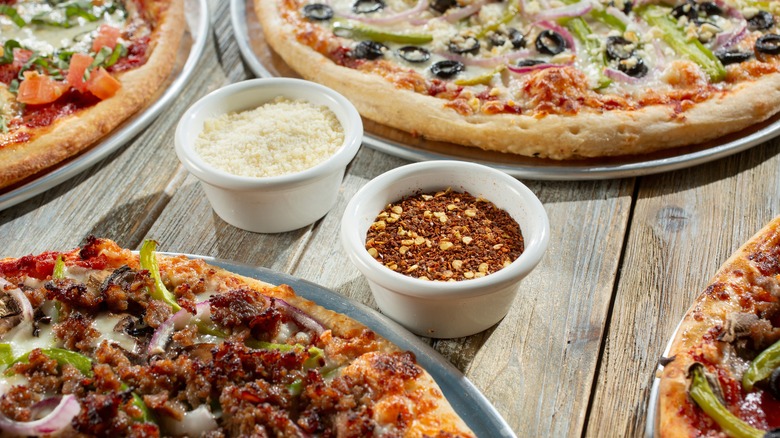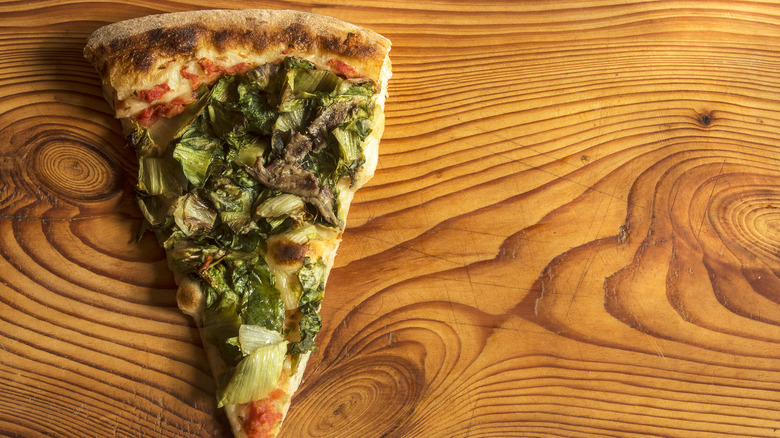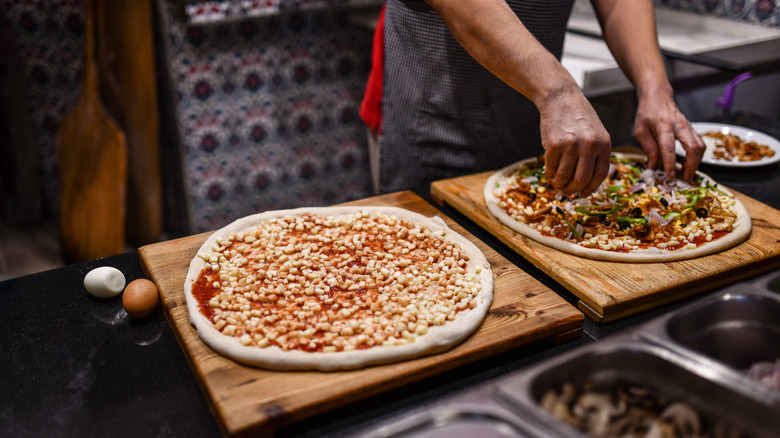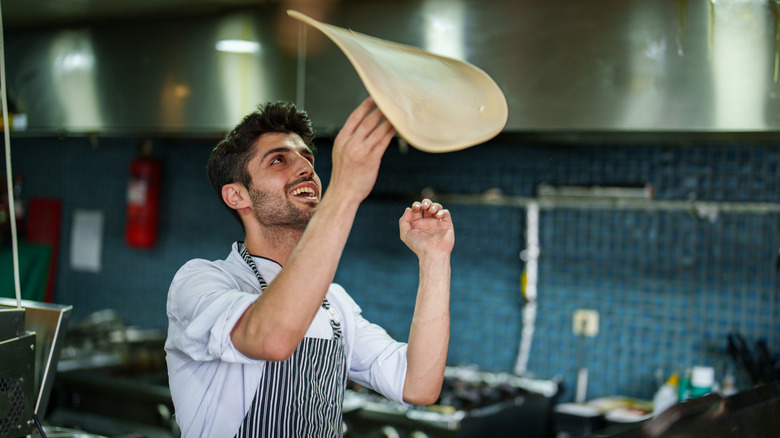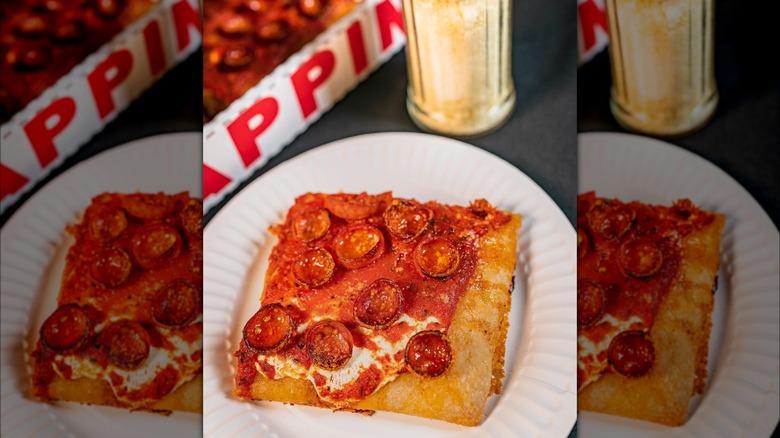11 Red Flags You Should Always Look For At A Pizza Shop, According To The Pros
Nobody's got time for bad 'za. Few things beat sinking your teeth into the blistered char of a hot slice, folded into submission and topped with crispy, gloriously greasy pepperoni. For true fans, pizza wins every time ... except when it doesn't. Kick sorry slices to the street as we uncover the tell-tale signs of a bad pizza joint, so your next pie is sure to be 100% fire.
We tapped entrepreneur, restaurateur, and CEO of Prince Street Pizza, Lawrence Longo, for his exclusive take on what truly makes or breaks a pizza shop. Longo first got friendly with the New York City original in 2018, six years after the celebrity-favorite shop made its Gotham debut. What's the secret sauce? "For Prince Street, I really think it's the components of all of its parts, the crust, the sauce, the cheese," Longo told Forbes in 2024. "We care about all of it. We try to use the best ingredients. We make everything in-house." Prince Street Pizza remains the hypebeast of pizza places for good reason. (Officially, that reason might be the square-shaped vibe of its trademarked Sicilian SoHo Spicy Spring.)
First looks to last gasps, Longo shares the difference between an average shop and a great one. Whether it comes down to the aromas floating on the breeze, a love/hate relationship with reviews, peacing out on soggy slices, or zero grated Parm, these red flags reveal when a shop isn't in it to win it.
Walk on by a cluttered entrance
The first signs of a potentially unclean interior situation can be seen from a mile away — or, by the front door of the pizza shop. "I would never judge a book by its cover," shares Lawrence Longo, offering a diplomatic take on the greater pizzaverse, "But cleanliness and too many promotions in the window would be a good indicator to stay away." In this case, that first impression is everything.
If the eyes are the window to the soul, the entrance of a pizza shop is the portal to a possible sketchy relationship with the health department. But it's not as much about the presence of signage as it is about the maintenance and care of the entry in general. Longo adds, "Neglected landscaping and litter around the entrance could be a key indicator of an unclean business." Maybe the sidewalk in front of your favorite local pizza shop is covered in napkins, paper plates, and gum that dates back to the 1700s, but if it's a new-to-you restaurant, you should be lured in by the effort a shop puts into keeping the place looking spick-and-span.
Your nose knows the smell of a good pizza place
It's almost impossible to resist the tantalizing aroma of toasty waffle cones outside an ice cream shop, or the scent of fresh-baked bread from a neighborhood bakery. But whether it's a marketing strategy, a happy accident, or both, any slice shop hoping to win over fans should also smell like toasty, cheesy, comfort-food heaven. If you can't smell the pizza, keep walking down the streetza.
So why might the absence of a pepperoni perfume and crust-forward cologne be the sign of a below-average shop? Lawrence Longo notes, "It usually means they are not making the product on-site with fresh ingredients." In contrast, and likely in reference to Prince Street Pizza which goes so far as to filter the water at its many shops outside of the Big Apple just so it tastes like New York City H2O, Longo lays it on the table, adding, "Ultimately, the quality of the pizza itself is the best indicator of whether the shop is worth your time."
Ditch the dried-out slices and the abandoned pies
Ever really lean in and take a good, long look at the pizza in the display case? If you spot whole, untouched pies languishing behind the glass and dried-up slices looking like grim death, there's a good chance that pizza shop isn't seeing a whole lot of action from customers. (Nobody wants to be the first to fold up an old, abandoned slice of leathery pepperoni.)
You can sabotage your homemade pizza with a rolling pin, but a shop could destroy a perfectly edible pie by leaving it to perish under the heat lamp. Think you might have stumbled upon an ancient pizza-shaped archeological dig? Just keep this advice in mind when assessing a "well-seasoned" slice. "Dry, hardened crust, discolored cheese, and shriveled toppings would be good ways to tell the pizza's been sitting out too long," Lawrence Longo explains.
Along with judging how long the pizza's been on display, you can also peep the restaurant's employees to suss out a stop-worthy pizza shop. Longo adds, "Another way to tell is to see how busy the staff are working in the store." If orders are consistent and the dinner rush is booming, that pizza kitchen will be cranking out fresh pies that are definitely worth tasting.
Cut out the cuppy pepperoni at a low-grade shop
These days, cup and curl pepperoni at a pizza shop is probably a good sign. (Maybe not for Elvis, who had a thing for a slice with barbecued pulled pork, but most of us pizza lovers prefer to roll with the 'roni.) Still, curled-up pepperoni at a place that isn't cooking a quality pie can be a bad sign.
With Prince Street Pizza often getting props for starting the trend of cuppy pepperoni in 2012, Lawrence Longo explains, "Cup and curl pepperoni is a style of pepperoni that curls up around the edges and forms small cups when it's cooked. Often seen on pizzas baked in high-temperature ovens, where the pepperoni slices shrink and crisp up at the edges, creating a distinct 'cup' shape." Even if it's not the cup-style cut, he says pepperoni with curled edges is often "a good sign."
Whether this flag waves bright red, or waves you in for a slice, it all comes down to the reason for the pepperoni's flipped-up edges. If the pepp's edges are dried-out and rubbery from sitting under a heat lamp too long, sashay away. But if they look like little crisped-up discs, still hot from the oven, dig in.
Skip the outsourced sauce
Sure, we can dress up a ho-hum pizza sauce with something that shamelessly breaks tradition. But when you're hunting down a top-shelf shop slice, you'll get the most flavor by hitting up a spot that's slinging a seasoned signature sauce.
Fully backed by the popularity of Prince Street Pizza's beloved spicy pizza sauces, which are crafted from heritage family recipes, Lawrence Longo notes that it's "probably a bad sign" if the shop doesn't cook their own gravy. "It's definitely not going to be a unique flavor," he says. "It will taste the same as all the other pizzerias that don't make their own sauce." The same theory could also be true if you're not seeing any visible pizza prep like dough being tossed into the air, sauces being ladled onto aspiring pies, and fresh sausage and mushroom toppings patiently waiting their turn. While a tucked-away kitchen isn't always a red flag, Longo says, "It could raise some questions depending on the context and your expectations of the pizzeria." We aim for pizza excellence, and according to Longo, it starts with a killer in-house sauce.
Don't go for the burgers and stay for the 'za
If your dinner party crew is feeling like different cuisines, you might aim for a place that offers something for every taste. (Pizza, burgers, and sushi — oh my!) But if you're hoping for really good pizza, consider it a serious red flag if a pizza shop menu features anything other than a superior 'za.
When asked whether pizza shops that offer multiple cuisines could be trying to do too much at once, Lawrence Longo confirmed, "Yes. Absolutely." Of course, we're not talking about the brick oven pizza shop that also offers a side of buffalo wings, a house salad, or a basket of chewy garlic knots. And we have a parking space permanently reserved in our hearts for fried, cheesy risotto balls and a slice of creamy New York cheesecake (hi, Prince Street Pizza). But if the sides seem to be taking over the main menu, or the confused cuisines have nothing to do with our favorite Napoli import, think twice about spending your cash on a slice at that shop. Whether or not the restaurant has the equipment to dedicate to a perfect pie, or is capable of moving the freshest ingredients through the kitchen, that outpost definitely isn't focused on the one thing that matters: dishing up the best slice you've ever tasted.
Don't sleep on bad reviews and no social media presence
Crowd-sourced restaurant review sites have come a long way, with Yelp launching a Best New Restaurants series in 2023, and Reddit ... well, still being Reddit (shoutout to r/Pizza). As much as we may loathe those notorious tales that begin with, "If I could give it zero stars, I would," Lawrence Longo says consistently poor reviews paint a clear picture of a bad pizza shop. "Love it or hate it, Yelp and Google reviews are good indicators," he explains.
While we can surely take the most unhinged critiques with a grain of salt, a majority of reviews can help conjure a realistic vibe for a place way before you ever walk in. Lots of happy customers posting about similar satisfied experiences? Green flag. (As one Prince Street Pizza fan posted, "I love this place sooooo much! Literally every time I'm here, I order the naughty pie and it hits every time.") But tons of unhappy customers consistently complaining about the shop being a waste of time? Reply apology tours from managers? Unappetizing photos? Red flags.
Also worth noting, fellow Information Age-ers, it's equally bad news if a pizza shop has no social media presence at all. (If pizza's not on TikTok, does it even exist?) Longo says, "Everyone should have a social media presence, and if the [bad] Yelp/Reddit reviews are consistent over a long period of time, I'd be weary." So, on the flip side, does he think that an uber-popular pizza shop is automatically worth trying? "I would say so," he confirms.
No toppings, no stopping
Even celebrity chefs can't get enough of shelf-stable, grated Parmesan cheese. But while a complete oversight on the grated Parm isn't a complete red flag, it might mean that particular shop isn't too concerned with catering to the deepest desires of its fan base.
"It's not necessarily a red flag because every pizza shop offers their own experience," Lawrence Longo says, allowing a long leash for a little branded flair in pizza hospitality. (Prince Street Pizza famously — and with a wink — doesn't serve sides of ranch, mayo, blue cheese, or ketchup at any of its outposts.) Still, he adds, "Some basic condiments that are expected in most traditional pizza shops are having Parmesan cheese, red pepper flakes, and sometimes even oregano or garlic powder is standard. If these common condiments are missing, it might suggest the shop is cutting corners or not prioritizing customer experience." According to Yelp reviews, Prince Street Pizza keeps the custom-curious crowd content with Parmesan cheese, garlic, and as many red chili flakes as you could ever want.
Skip the soggy vegan slice and go for the gold
To all the vegans and vegetarians, and the Meatless Monday masses, your go-to veggie pizza option doesn't have to be the soggiest slice on the block. If the crust is barely sponging up sloppy toppings made of watery green peppers and slimy spinach, get your vegan pie on at a different shop. (You already gave up bacon — you deserve a toasty crust.)
While the soggy pizza phenomenon can occur for a variety of reasons — like an underbaked crust; heavy, overloaded toppings; a hot pie that wasn't allowed to release its steam; or an overwhelming amount of sauce — a great pizza shop knows how to navigate the common perils of the veggie pie. On the flip side, a lesser shop might not have the bandwidth to put the proper care into the one menu option that might appeal to the meatless lover. Rightly touting his own company's pie, which features "sweet marinara" sauce, vegan cheese, fresh basil, and EVOO on a Sicilian SoHo square, Lawrence Longo advises, "Try Prince Street Pizza vegan slice and you'll never eat soggy vegan pizza again."
Hang out to clock the hand hygiene
With Americans chowing down on an average of 350 slices of 'za per second, if a shop hopes to stay competitive in a $233.26 billion global pizza industry, it's gonna have to hustle on the pies to keep up with demand. But that doesn't mean cutting corners on sanitary pizza craft. If you spot bad hand-to-pie contact, you might want to move on to a place that values your gut and not just your wallet.
This one requires a little reconnaissance, but if you're hoping to walk away with a slice that's got no, ahem, "extra toppings," it's worth taking a minute to check out how employees handle the food. While you might assume that the whole crew should be wearing gloves, that's not necessarily a make-or-break sign. As Lawrence Longo describes it, those in closest contact with the pizza might even be sporting bare hands. He says, "Pizza makers do not need to [wear gloves], but they should frequently be washing their hands." If you spot a well-maintained hand-washing station, and maybe a sudsing-up in between working the register and assembling the pies, signs point to eating the pizza. For anyone who's still a bit wary of human-to-pepperoni contact, Longo shares, "All germs are killed in the 500-degree pizza oven."
Don't do day-old dough
Maybe you've got visions of pizzaiolos working by the glow of a wood-fire oven, spinning pizza dough rounds on their fingers like '90s NBA stars. But even if the scene at a pizza shop isn't quite that quaint, you should still see the evidence of fresh-made pizza dough if it's a quality outpost. "In general, daily fresh dough preparation is a hallmark of a good pizzeria," assures Lawrence Longo.
"Some of the benefits of fresh dough are better flavor and texture, customization and control, quality, and consistency," he explains. Prince Street Pizza makes the dough for its Sicilian square pizzas with flour and a relatively standard list of ingredients: sugar, salt, oil, water — and zero eggs. But Longo doesn't throw a wet towel on the practices of other shops. He adds, "High-volume pizza shops might prepare dough in advance to meet demand, but this doesn't necessarily mean the quality will suffer if managed properly ... cold-fermented dough can also be excellent if done right." That said, he has little patience for a product that's ever been on ice. "Frozen dough, on the other hand, is typically a sign of lower-quality pizza," says Longo.
Pizza advice from Prince Street Pizza's Lawrence Longo
Finally, a few green flags you can tuck inside your pizza box. Almost immediately upon entering a new shop, you'll likely be able to judge how immersive the experience could be just by tuning into your feels. As Lawrence Longo notes, "The best pizzerias encapsulate all five of the customers' senses. Sight, smell, taste, touch, and sound." (And, for some of us, melty pizza cheese checks all of these boxes.)
Once you've decided to stay, and you want to go for a taste, Longo offers a strategy for truly sampling the best that a shop has to offer. He says, "Order three slices ... Ask for the most popular slice, the freshest, and the employee's favorite slice." If you find yourself standing outside any of the Prince Street Pizza locations in New York City, Southern California, Las Vegas, Toronto, or Miami (with more on the way — there's even a drive-through slice shop inside a former Arby's in Los Angeles), you know exactly what to do.

